Inside the exquisite Tibetan monasteries salvaged from climate change
 Tulsi Rauniyar
Tulsi RauniyarExtreme weather is threatening these intricate 15th Century Tibetan monasteries, but local people are rising to the challenge to preserve them.
Tashi Kunga stands before the Kag Choede monastery, built into the Dhaulagiri mountain range on the Tibet-Nepal border. The monk's carmine robes glint in the rain, as he recounts the ancient legend of Guru Rinpoche's battle with a demon.
The legend goes that centuries ago, a demon wreaked havoc on a monastery in Tibet. Guru Rinpoche chased it south to Upper Mustang in Nepal and defeated the demon following a ferocious battle, burying the demon's remains across the mountain range. The people of Mustang honoured the sacred grounds by building monasteries atop the demon's body parts.
Climate Guardians
This article in the Climate Guardians series was supported by funding from the European Journalism Centre, through the Solutions Journalism Accelerator. This fund is supported by the Bill & Melinda Gates Foundation.
"And right on the demon's heart, the capital of Lo Manthang [was built] in 1380," says Kunga, pointing towards the narrow alleys, ancient monasteries, and flat roofs adorned with prayer flags of one of the last medieval walled cities in the world.
For centuries, Lobas, the indigenous people residing here, have thrived in this remote region situated on top of the Tibetan Plateau. One thing that has remained constant is the monasteries, locally known as "Gonpas", the most treasured heritage of the region. But almost two decades ago, many of these monasteries, which date back to the 15th Century, started crumbling.
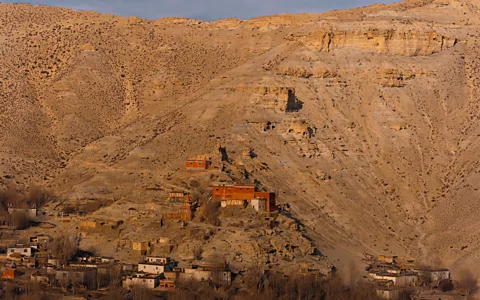 Tulsi Rauniyar
Tulsi RauniyarExperts sounded the alarm, attributing the collapse to the severe impacts of climate change. Data indicates a significant increase in the intensity of storms and rainfall across the region. Increased rainfall saturates the rammed-earth buildings, as moisture in the soil is drawn upward into the walls, leading to issues such as leaking roofs and rising damp.
Carbon Count
The emissions from travel it took to report this story were 70kg CO2. The digital emissions from this story are an estimated 1.2g to 3.6g CO2 per page view. Find out more about how we calculated this figure here.
"For us, Buddhists, the paintings and the artifacts in the monasteries are embodiments of the gods themselves, and we can't worship a half-damaged idol," says Kanga. "There was no one to repair it. Our heritage was slowly decaying away. We thought the deities were angry."
Buddhist monasteries have long been revered as the foundation of Tibetan culture, serving as a vital hub for the creation and safeguarding of both tangible artifacts and profound intellectual traditions. But as unprecedented weather patterns pose a threat to their cultural heritage, local community members have stepped up to restore them. Local people have gained diverse skills, from reinforcing walls to crafting metal statues and restoring paintings.
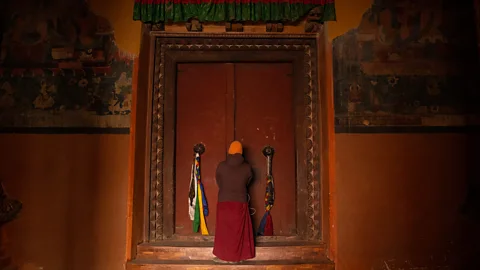 Tulsi Rauniyar
Tulsi RauniyarOver the past 20 years, a team of local Lobas trained by Western art conservationists have replaced the old, leaky roofs of the temples with round timbers, river stones, and local clay for waterproofing, and have restored the wall paintings, statues, sculpted pillars and the ceiling decorations, giving these centuries-old monuments a new life.
Luigi Fieni, the lead art conservator at Lo Manthang, has spearheaded the restoration project. Transforming a community of farmers into conservators has been challenging, he says. Most of the Lobas had never held a pen or a paint brush before, and undertook extensive training before they began restoring the 15th Century paintings.
"But it all worked out," says Fieni. "Tourists visiting Mustang were keenly interested in religion. So we felt these sacred artifacts needed preservation not only for their historical significance but also for sustaining livelihoods here."
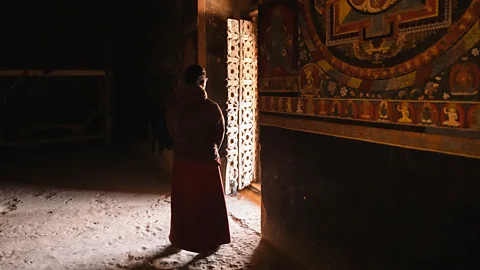 Tulsi Rauniyar
Tulsi RauniyarThe team, initially made up of 10 members, has grown to 45 conservators, mostly women, although there was initial reluctance to accept any women in the group. According to local tradition, women are prohibited from touching sacred objects. However, women did eventually take part in the Lo Manthang restoration project.
"It took years of discussion and negotiation with the local clergy and community, but we succeeded in including local women in the wall-painting conservation team," says Fieni.
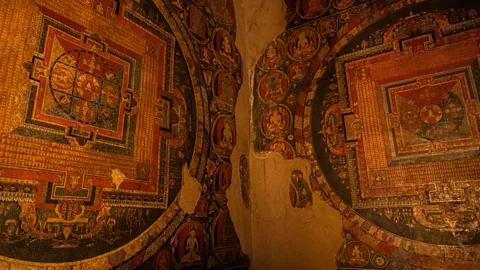 Tulsi Rauniyar
Tulsi RauniyarMarried Tibetan women are typically responsible for cooking, cleaning, milking the animals, churning the butter and collecting yak dung for fuel. Tashi Wangmo, 40, used to spend her time herding yak, collecting and selling herbs, and doing various odd jobs, but it never provided much income. When she received the opportunity to pursue new training and earn a daily wage in the restoration project, she jumped at it.
"It enabled many of us [women] to break free from the limits of our homes, expand our skillsets, and find new opportunities," she says. "Otherwise, life remains stagnant for us, confined to the corners with little purpose or prospects."
Another female restorer Dolma Tsering, 42, wasn't there just to learn art or refine her painting skills. She believed that by participating in the monastery's restoration, she would earn spiritual merit and contribute to the promotion of Tibetan Buddhism through her work.
"Once you compare the faded, scraped-off outlines of deities and the vibrant expressions of revived figures, you will recognise the incredible scale of everyone's efforts. It has increased the cultural value of Lo Manthang," says Tsering. "And as women, we were able to play [a role] in it."
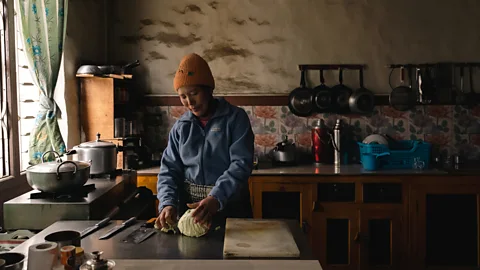 Tulsi Rauniyar
Tulsi RauniyarBut the community continues to face challenges amid the onslaught of climate change. The Himalayas are particularly vulnerable to rising temperatures and climate impacts. When rainfall comes, it pours in abundance, but prolonged drought is also common. In 2023, heavy rainfall flooded many small rivers and brooks in Mustang, leading to widespread flood damage in neighbouring villages.
The roads facilitating easy transport in the region have also contributed to rapid population decline, with many Lobas moving to cities in search of economic opportunities, says Gurung.
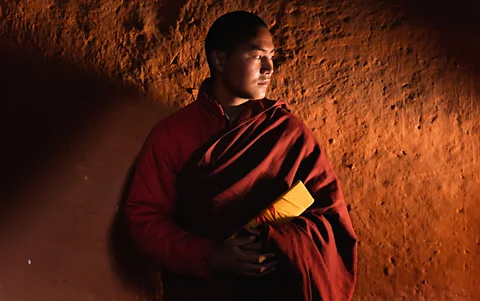 Tulsi Rauniyar
Tulsi RauniyarTashi Gurung stands out as a prime example of a farmer-turned-restorer who chose to remain in the region. He wasn't exposed to Tibetan Buddhist art as a child, but today he owns an art gallery in Lo Manthang.
His gallery showcases a remarkable array of thangkas, portraying the Buddha, his teachings, and various deities and other spiritual beings such as the bodhisattvas. His art sales not only sustain himself but also enable him to send his children to school.
Reflecting on his decision to stay, Gurung acknowledges the profound impact of monasteries on his life. "If it weren't for the monasteries, I might have followed my friends who left Mustang for better opportunities abroad," he says.
 Tulsi Rauniyar
Tulsi RauniyarThe restoration efforts have sparked a cultural renaissance, according to Fieni. Numerous women and young people have received training in traditional craftsmanship, long-forgotten festivals have been revived, magnificent wall paintings restored for religious purposes, and monasteries and nunneries are thriving once again, he says.
"Om mani padme hum," the students at the Lo Monastic School chant the mantra that Tibetans use to invoke the bodhisattva of compassion, who is also Tibet's patron saint. Today, Kunga says, the danger imperilling the walled city of Lo Manthang and its age-old monasteries doesn't stem from mythological demons, but rather from the impacts of climate change.
"If we want to save our culture, we all need to join hands and save the monasteries because everything here spins around religion," says Tsering.
--
For essential climate news and hopeful developments to your inbox, sign up to the Future Earth newsletter, while The Essential List delivers a handpicked selection of features and insights twice a week.
